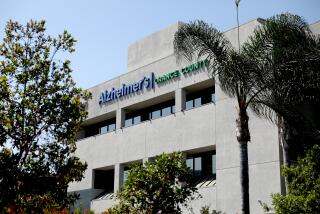Used quickly, stroke drug can help
- Share via
For people who have suffered a stroke, lingering disabilities are a wrenching reminder of what their lives used to be. A lopsided smile, difficulty moving an arm or a leg, trouble articulating thoughts -- all can be among the devastating and frequently permanent consequences of a stroke. In fact, of the almost 6 million Americans who have had a stroke, only 10% will recover completely.
The numbers shouldn’t be this grim.
The use of a drug called tissue plasminogen activator, or tPA, can improve the chances of recovery by up to 30%, studies have shown. The tPA dissolves the blood clots responsible for causing most strokes, thereby restoring blood flow to the brain -- but most stroke victims don’t get it.
“Less than 5% of stroke patients actually receive tPA,” says Dr. Bruce Ovbiagele, director of the Olive View -- UCLA Stroke Program and a spokesman for the American Stroke Assn.
Time constraints are the main reason. If too much time passes, the damage caused by the clot is no longer reversible. To be effective, tPA must be given within three hours after stroke symptoms begin. In fact, the sooner it’s administered, the better. “After three hours, it’s a case of diminishing returns,” Ovbiagele says. “The risks associated with tPA use begin to outweigh the potential benefits.”
Administering the drug quickly isn’t easy. For starters, most patients don’t get to the hospital fast enough. A study published in May by the federal Centers for Disease Control and Prevention found that fewer than half of all stroke victims arrived at the ER within two hours of developing symptoms.
Frequently, victims simply don’t recognize that they are experiencing a stroke. “People really don’t know much about strokes,” Ovbiagele says. “Only about 27% of the public can name one stroke symptom.” And, in some cases, cognitive problems such as confusion caused by the stroke can impair a person’s ability to understand what is happening.
Many people don’t take appropriate action even after they realize they need help. Taking an ambulance is the quickest way to get to the hospital, but instead of dialing 911, people frequently call on friends or family members for assistance -- or they try to contact their personal healthcare provider for guidance. Only half of all stroke victims in the CDC study arrived by ambulance.
Sometimes stroke victims are physically incapable of seeking assistance. If the stroke has affected their speech, they may be unable to communicate verbally; if it has caused significant motor weakness, they might not be able to get to a telephone.
After patients arrive in the hospital, they can face additional delays. Before tPA can be administered, possible stroke victims must undergo a thorough evaluation as well as a CAT scan of their brain, to ensure that they have suffered a stroke caused by a blood clot. (Strokes can also be caused by bleeding in the brain.)
This type of rapid triage, diagnosis and treatment is beyond the capabilities of many medical centers. “Many hospitals simply don’t have the personnel to follow treatment protocols,” Ovbiagele says.
Some hospitals have been designated as “primary stroke centers,” designed and staffed to help eliminate unnecessary delays and ensure that stroke patients get the best care possible. Unfortunately, there are only 32 of these centers in California and just one in Los Angeles, UCLA Medical Center. For a list of other stroke centers, to go www.strokecenter.org/strokecenters.html.
But time constraints aren’t the only reason tPA isn’t given. Some doctors who are unconvinced of its benefits will not administer the drug. In a survey of 1,000 emergency room physicians conducted in 2004, 40% reported that they were not likely to use tPA, even under ideal conditions.
Officially, the American Academy of Emergency Medicine does not support tPA as the standard of care for strokes. The organization points to the drug’s potentially serious side effects, particularly bleeding into the brain, and calls into question the studies that have shown the drug to be effective. It points out that several other trials of tPA therapy have not shown such promising results.
The academy also argues that the studies were conducted at institutions with dedicated stroke teams and excellent diagnostic resources, and suggests that other settings might not produce comparable results. That position is not without some merit: tPA can, in some patients, do more harm than good. However, it’s the only current hope for stroke victims. “There are no other approved options for the treatment of acute ischemic stroke,” Ovbiagele says. “It’s tPA or nothing.” The American Heart Assn. and American Stroke Assn. have developed stringent guidelines to help ensure that the drug is used only in people who are least likely to experience adverse effects and who are most likely to benefit.
Although some patients will not be eligible to receive it based on their medical histories or CAT scan findings, no one should be excluded simply because the clock ran out.
To that end, people need to learn more about strokes. They must recognize the major symptoms and act appropriately if they suspect someone has suffered a stroke: Call an ambulance and request transport to a primary stroke center, if possible.
--
Dr. Valerie Ulene is a board-certified specialist in preventive medicine practicing in Los Angeles. She can be reached at themd@att.net.
--
(BEGIN TEXT OF INFOBOX)
Symptoms
The most common symptoms of stroke are sudden:
Trouble seeing in one or both eyes.
Dizziness, trouble walking or loss of balance or coordination.
Severe headache with no known cause.
Weakness or numbness of the face, arms or legs, especially on one side of the body.
Confusion, trouble speaking or trouble understanding.
From the American Stroke Assn.






